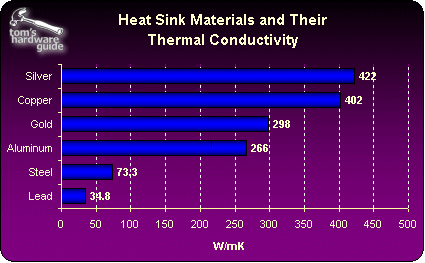A Cool Bunch: How To Put A Lid On The Die Temperature Of Your Athlon
The Theory Behind The Dream Cooler
It's not hard to sum up what users expect of their dream cooler: it should be easy to mount and should run quietly. And it should offer enough extra cooling capacity so that you can upgrade your processor once or twice.
Specifications Of The Processor Maker
The most important design specifications given by AMD for an Athlon cooler and for the computer case are as follows:
- Maximum total weight: 300 grams (for coolers that are affixed to the socket with a clip);
- Maximum external dimensions: 60 x 80 x 60 millimeters;
- The internal temperature, TA , immediately surrounding the cooler must not exceed 40° Celsius, no matter what the operating state of the CPU is.
General Physical Requirements
The cooling capacity/heat conduction provided by a cooler can be described by the following (extremely simplified) equation:
Iw = G*TD -TA with G=κ (A/l)
whereas
Iw : Heat flux
G: Heat conductivity coefficient
κ: Thermal conductivity of the cooler material
A: Surface through which heat flows (contact surface between die and cooler)
l: Path taken by heat flux
TD : Maximum acceptable die temperature according to specifications
TA : Temperature of the air surrounding the fan
According to this equation, the driving force for the heat flux Iw (Iw stands for the heat dissipated by the processor) is the difference in temperature between the die and the internal case temperature. For a given difference in temperature, the heat flux will be greater (in other words, more heat will be dissipated) the higher the thermal conductivity coefficient (or rather, the lower the thermal resistance) of the cooler is. And for the thermal conductivity coefficient to be high, the thermal conductivity of the cooler material needs to be as high, the contact surface as large and the path taken by the heat as short as possible.
Get Tom's Hardware's best news and in-depth reviews, straight to your inbox.
Heat conductivity coefficients for different materials.
Current page: The Theory Behind The Dream Cooler
Prev Page A Round-up Of 55 Coolers For AMD Processors Next Page Don't Lay It On Too Thick: The Tight Grease